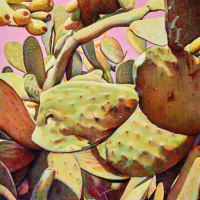37. TIM MAGUIRE

Tim Maguire first came to international prominence during the mid-1990s, when figurative painting was reassessed and revitalised in the postmodern era. His sumptuous, large-scale paintings of flowers and fruit simultaneously reprised and subverted artistic tradition. Maguire re-presented the imagery of Dutch still-life painting as a series of grand, cinematic close-ups. Devoid of its original context, Maguires subject would appear flattened and partly abstracted, its painterly surface degraded through the application of a corrosive solvent. And yet, the innate beauty of the image would prevail even as one became conscious of its ultimate impermanence. Invoking the memento mori symbolism of Dutch still-life, Maguires early flower paintings juxtaposed vitality and death, beauty and decay.1 Ambivalence has always been at the centre of Maguires art.
Untitled 20070302 is an outstanding example of Maguires work from the mid- to late 2000s, when the artist began to experiment with more contemporary source material. Depicting a dense swathe of prickly pear (Opuntia), the present work is derived from photographs taken by Maguire during regular visits to the Balearic islands, off the coast of Spain.2 Rendered in dramatic chiaroscuro, the prickly pears broad, fleshy outlines overlap to form a robust tableau. As the artist recalled, I was intrigued by the almost fractal nature of the plant, where the shapes and patterns were repeated at different scales, disrupting the conventions of perspective and spatial representation.3 With its pastel pink backdrop, the image immediately conjures thoughts of summery languor from Majorca to Crete, Miami or Palm Springs. That is, until one remembers that in many parts of the world (and indeed, Australia), the prickly pear has been declared an invasive species. Maguire was nonetheless fascinated by the plants formal possibilities: the prickly pears offered a subject where directional light fell on surfaces, revealing form and casting strong shadows.4 In contrast to his flower paintings, in which conventionally beautiful forms would appear looming and monstrous, Maguire revelled in the unorthodox allure of his new subject: I found great beauty in the cactis sculptural forms, and the negative shapes they created against the bright skies.5
Maguires technique is very much his own. As described by Tony Godfrey in the 2007 monograph on the artist, Maguire begins with a digital photograph, which is enlarged and cropped to his liking. He then employs computer software to separate the colours in a photograph into the three constituent colours used in the commercial printing process: cyan, magenta and yellow. Then, using printouts of each pigment as a guide, he paints each by hand as a separate layer, eventually building up the image as a whole.6 Yellow is applied first, followed by magenta and cyan. Maguire splatters each layer of translucent paint with solvent before adding the next, such that the finished image appears mottled and luminous.
Perhaps the most intriguing aspect of Maguires process is how much he leaves to chance. As the artist observes:
Painting to me is a delicate interplay between control and randomness. The use of the source photo and the mechanical origins of the colour separation process suggest that the outcome is predictable; the vagaries of the paint and the inexactitudes of the eye mean that the result is anything but The process is something like a game where rules are followed, actions are repeated, but the outcomes are unforeseen.7
The author wishes to thank Tim Maguire and Martin Browne for their generous assistance with the research for this essay.
FOOTNOTES
1. Tim Maguire in conversation with Maria Stoljar, Talking with Painters, Episode 92, 4 June 2020 (accessed May 2022): https://talkingwithpainters.com/2020/06/04/ep-92-tim-maguire/
2. Tim Maguire in email correspondence with the author, May 2022.
3. Ibid.
4. Ibid.
5. Ibid.
6. Godfrey, T., Light, Skin and Beauty, in Tim Maguire, Piper Press, Sydney, 2007, p.14
7. Op. cit. Maguire, T., Everything Changes: Tim Maguire 2002-2017, Newcastle Art Gallery, Newcastle, 2017, n.p.
Catherine Baxendale